Although it’s cute to watch dogs barking on command, and you want them to bark whenever a stranger comes over, barking – especially excessive barking – can be a real pain in the mutt.
Loud dogs can irritate your neighbors, wake babies, and fray nerves, leaving a trail of headaches, crying infants, and quick-tempers in their wake.
Dogs vary a lot in terms of “volume,” and some breeds are typically quieter than others. So, if peace and quiet is important to you, consider adding one of the breeds below to your family (and avoid the more vocal dog breeds).
1. Basenji

Basenjis have a reputation for being quiet dogs, who only bark in the rarest of circumstances. And while this is true, they are not silent by any stretch of the imagination; they’ll whine, cry, moan and make a variety of other (strange, yet endearing) vocalizations. However, these noises aren’t likely to irritate your neighbors.
Basenjis are very unique dogs, who have a few peculiar personality quirks. Originally developed to accompany hunters in Central Africa, basenjis are smart, but headstrong.
They’ll learn commands easily, but they are not always willing to follow them. They also have a well-developed chewing instinct (definitely get these guys hooked up with some chew proof dog toys) and are always looking for the chance to dash out the door and go exploring.
On the plus side, basenjis are tidy dogs, who shed relatively little, so they make great dogs for neat freaks and allergy sufferers.
2. Great Dane
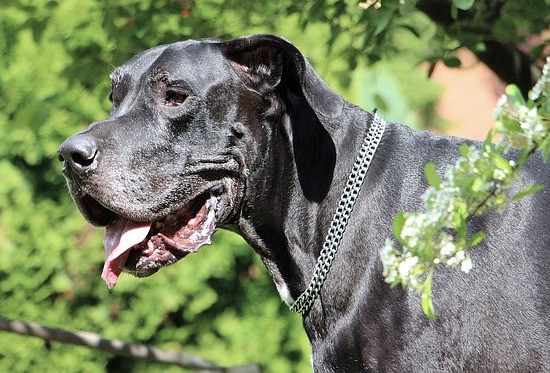
Great Danes are usually pretty quiet dogs who don’t bark very much. However, their gigantic lungs and lengthy vocal cords will rattle the walls of your home when they do.
Accordingly, while they won’t bark all night and frustrate the folks next door, they are probably not ideal for those living with extra-sensitive neighbors or strict noise ordinances.
Volume matters aside, Great Danes can actually be reasonable dogs for apartment dwellers. You just need to make sure to take them on several long walks each day. Aside from that, they’ll normally just like chilling on the couch with you.
Great Danes do have a pretty serious drooling problem, which can be pretty gross if you aren’t accustomed to that kind of thing. Just be sure to have a few clean rags on hand at all times to help contain the mess.
3. Bichon Frise
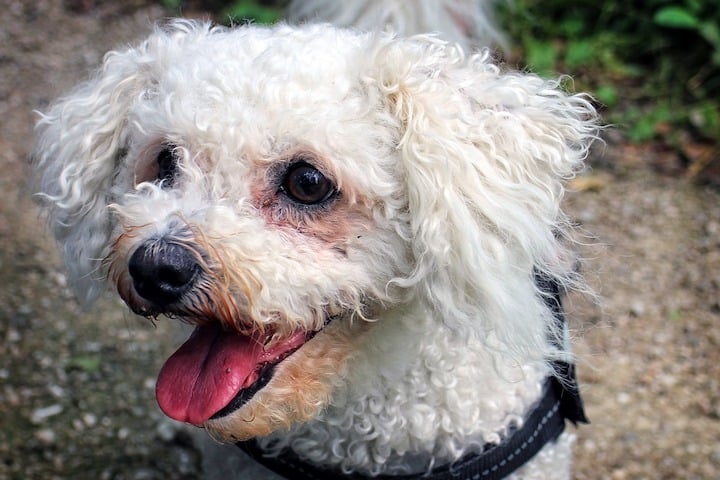
The bichon frise is a cheerful, energetic cutie, that usually adapts well to apartment life. They aren’t silent, and they will bark in response to appropriate stimuli, but they rarely engage in pointless nuisance barking.
In addition to being preciously pint-sized (they rarely exceed 12 pounds or so), bichon frises are also very smart.
They love to learn tricks and commands and crave a close, interactive relationship with their owners. These are not good dogs for those who are away from home for long periods of time, nor are they good for owners who won’t work to train them properly.
Bichon frises require relatively frequent grooming, so be prepared to develop a close relationship with your groomer. However, they do not shed very much, which makes them a great option for some allergy sufferers.
Check it out: Great Foods for Bichon Frises!
4. Greyhound

Despite their reputation for being incredible runners, greyhounds are actually pretty low-energy dogs who love to simply lounge about. Sure, they’ll take off after a squirrel at Mach 3, but they don’t want to run alongside you for miles and miles in a canicross marathon the way a Husky or Dalmatian would. Their exercise needs are actually rather low for their size.
Nuisance barking is very rarely a problem for greyhounds, so they usually make good apartment pets. They can be a bit shy around strangers or in unfamiliar situations, so be sure to socialize them properly.
5. Pug

Pugs are some of the most endearing dogs in the world, and their small size and quiet nature make them ideally suited for apartment life.
Like most other members of the Toy Breed Group, pugs love hanging out with their people and are happiest when sitting on the lap of their ma or pa. Pugs are pretty sharp canines, but their headstrong personality can make them somewhat challenging to train.
Pugs do suffer from a few health challenges, largely because of their flattened head shape. For example, pugs are intolerant of temperature extremes and they don’t swim very well. This shortened head also means that while pugs aren’t likely to bark a lot, they make a lot of weird snorty sounds while going about their day.
6. Poodle
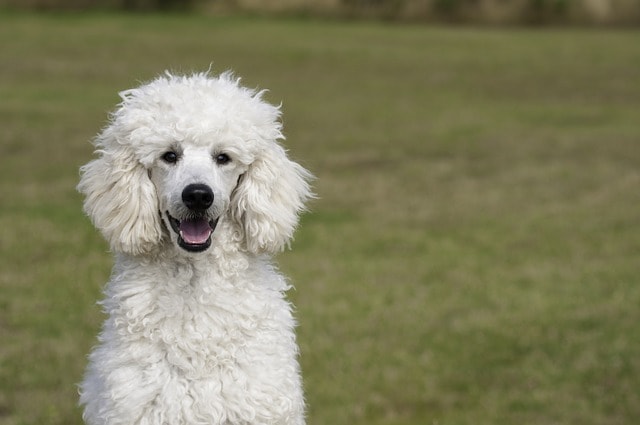
Poodles may project a refined, noble image, but that doesn’t mean they are aloof or distant; in fact, poodles are very warm dogs, who bond very strongly with their owners.
And while poodles actually make better guard dogs than most would think, they rarely bark for no reason. While there is plenty of overlap between the three different poodle sizes (toy, miniature, and standard), many consider the standards to be calmer than either of the small varieties.
Poodles are very smart dogs, who require plenty of mental stimulation and activity to prevent the development of problematic or destructive behaviors. It is important to train them properly, socialize them from a young age, and give them plenty to do on a daily basis (we suggest a few awesome puzzle toys and plenty of exercise).
7. Mastiff
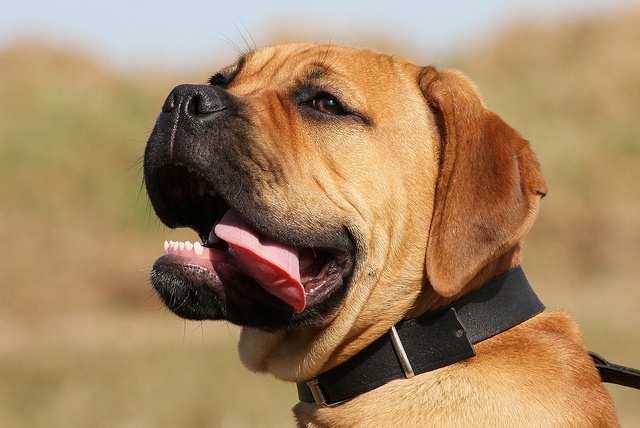
Mastiffs are a great example of “the strong, silent type.” These gigantic dogs have calm and confident personalities, and pointless barking tends to be beneath them.
However, while mastiffs aren’t very sonically imposing, they are farting, drooling, and shedding machines, so they definitely make their presence known.
Although they don’t have a super-high energy level, their incredible size (up to 220 pounds) means that mastiffs aren’t really suitable for small apartments. They will bump into everything you own, and they can even represent something of a safety hazard, given their immense bulk (not that they’d ever mean to do their owner harm).
But despite some of the challenges they present, mastiffs are great companions. They are usually great with older kids (because of their size, they shouldn’t be left unattended with small children) and typically bond very closely with their owners.
8. Afghan Hound
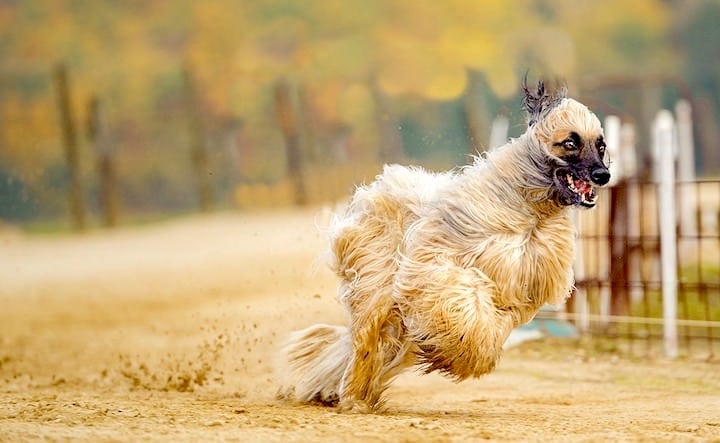
One of the most refined dogs on the planet as an ancient dog breed, the Afghan Hound is quite the fancy pooch, who rarely finds it necessary to bark at strangers showing up at the door or kids running around outside. In fact, Afghans are a bit shy and typically keep unfamiliar people at arm’s length.
Afghans certainly have their share of devotees, but they are not terribly easy dogs to care for. They require frequent grooming, they have an independent streak a mile wide, and they are not very easy to train (and this includes housebreaking). But those who love the breed tend to look past these challenges, and enjoy the surprisingly comical personality of these elegant and sensitive dogs.
Note that because Afghans are fleet-footed sighthounds, you don’t want to introduce them to a home that has small pets – they’ll just trigger the Afghan’s prey drive.
9. Saint Bernard
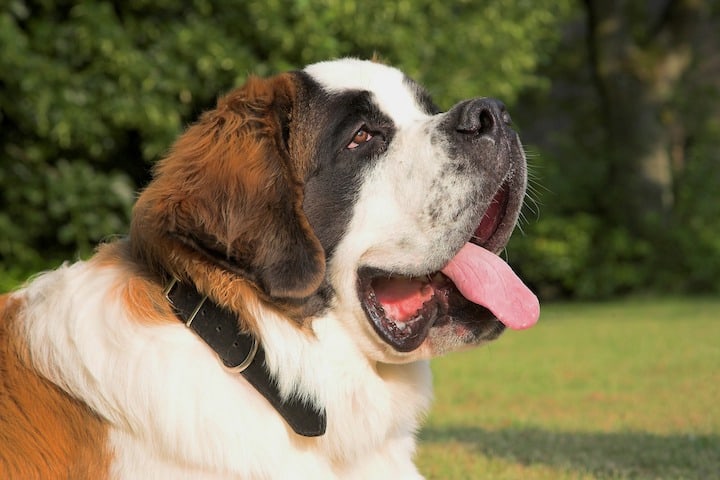
Gigantic and gentle, the Saint Bernard is a quiet and calm companion, who will rarely be bothered by things that would cause other dogs to bark. This doesn’t mean they aren’t ready to defend their family, just that they rely on their imposing size to discourage would-be threats, rather than their vocal cords.
Like a few of the other large breeds discussed above, Saint Bernards are fairly messy dogs, who shed and drool a lot. They take up quite a bit of space, but Saint Bernards are not terribly playful or rambunctious, so they can be suitable for medium-sized apartments.
Saint Bernards do not tolerate heat well, so they aren’t ideally suited for those who live in warm areas. Likewise, they aren’t fond of spending their days alone in the backyard – they want to be inside with their people.
10. Bull Terrier
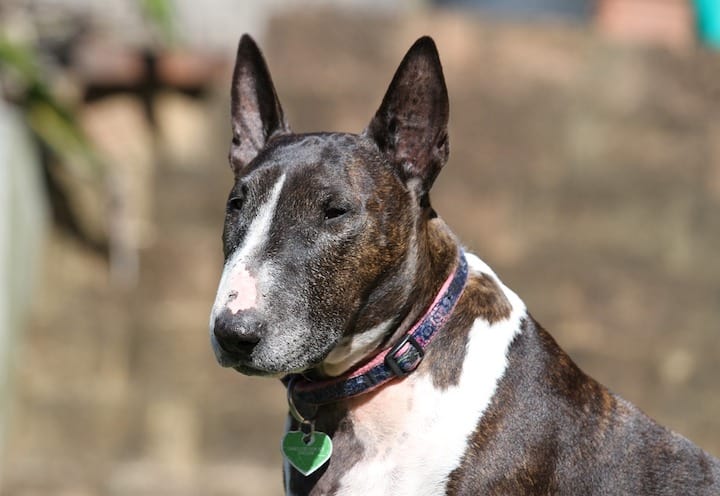
Cute, loving and spunky, the bull terrier is a wonderful family companion who rarely barks or causes much of a commotion. They want nothing more than to spend time with their family, and they do not tolerate being left alone for long periods of time. When left to entertain themselves, bull terriers frequently opt to chew on anything they can get their mouth on.
Bull terriers are people-oriented dogs, who play wonderfully with older children (their exuberance necessitates supervision with young children) and make friends with everyone they meet. They usually get along well with other dogs, although proper socialization is important from a young age.
Bull terriers (and bull terrier mixes, in many cases) are headstrong and a bit tricky to train, so they aren’t ideal for first-time owners.
Tips for Keeping Your Canine Quiet
No matter what breed you have or how loud your dog tends to be, you’ll probably want to do everything you can to keep your dog as quiet as possible – at least while you are inside. It is important to realize that dogs make noise in a number of ways besides barking. Their nails clatter across the floor, their tails smack into things, and they squeak their toys.
These types of things aren’t as loud as barking, but they can still be quite problematic for families with young children (or any light sleepers, really) or those who live in apartments.
Try to understand why your dog barks. Understanding why your dog is barking can help you figure out what you need to do to calm your pup down. Is your dog scared? On alert mode? Or is he just bored? Our guide on different types of dog barks can help you get a better grasp on what your dog’s racket is all about!
Avoid stoking your dog’s barking impulse. If you start talking to your dog and giving him lots of feedback every time he barks, you are going to wind up with a dog that barks far more often than is necessary or desirable. Instead, try to react calmly when your dog barks for a good reason, such as a knock on the door, but avoid reacting at all when your dog barks for no reason.
Teach your dog a “silent” command. This is not a terribly easy command to teach, as you need your dog to be barking first! It may be helpful to teach your dog to bark on command, so that you can then teach him to stop doing so. Nevertheless, despite the challenging nature of the command, many owners manage to pull it off.
Remove common stimuli that elicits barking. You obviously can’t plan for things like a cat walking by your dog’s favorite window or an unexpected visitor knocking on the door, it is often possible to avoid some of the things that make your dog bark. For example, if your dog goes nuts every time the neighborhood kids get off the school bus, try to prevent him by noticing them, by diverting his attention elsewhere or closing the windows.
Use carpets and rugs. The clickety-clickety-clickety-clickety sound of a dog pacing in the apartment above you can irritate even the most dog-friendly of neighbors, so try to cover your floors with something soft to muffle the sound.
Take your dog to the park more often. The more exercise and stimulation you provide to your dog, the more he’ll sleep and lounge about when you get back home – as the saying goes, “a tired dog is a well-behaved dog.”
In fact, many dogs can develop problematic barking behaviors when deprived of enough time to run, jump and play, so be sure to get your dog out more often.
Besides, he can probably bark to his heart’s content at the park, so he’ll work some of it out of his system.
Check out this video below to learn a great technique for teaching your pooch how to stop barking.
Does your dog hoot and howl all day and night, or is he a quiet pooch that rarely makes a peep? We’d love to hear all about it in the comments below. We’d also encourage you to share your own canine-quieting tips – maybe you’ll help out a fellow dog owner.
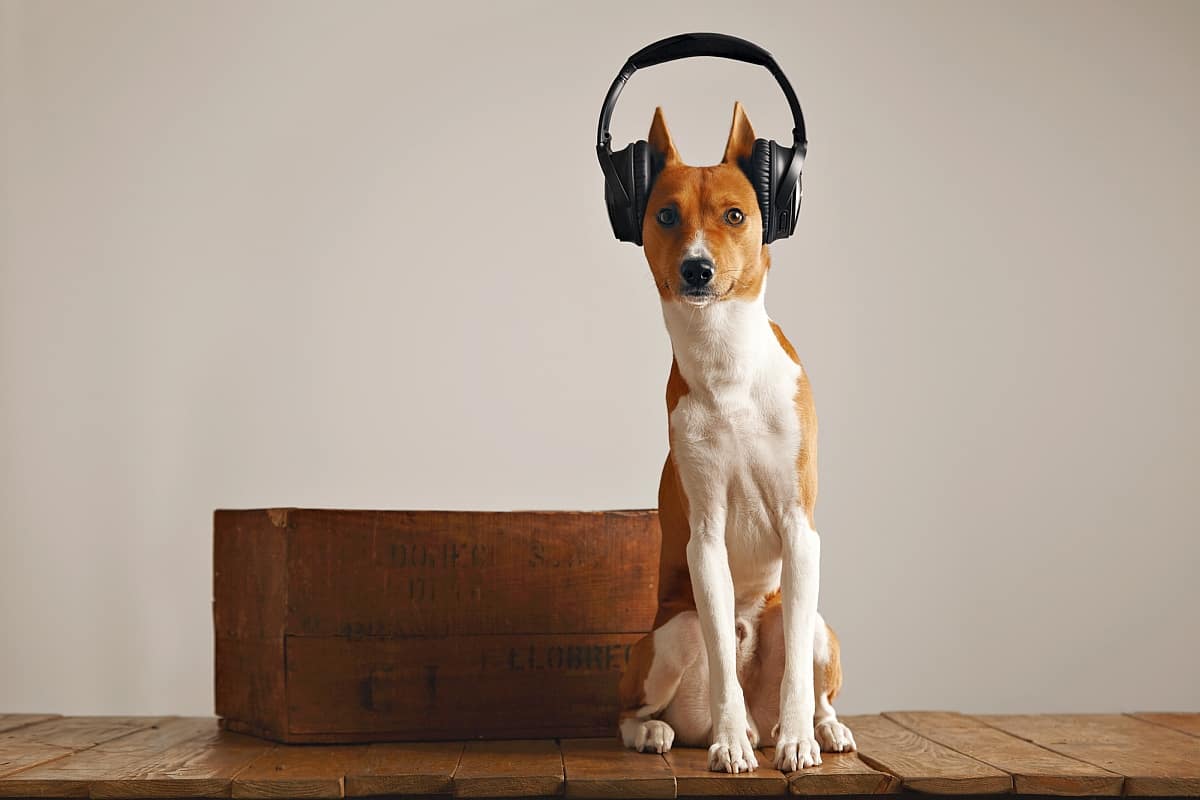



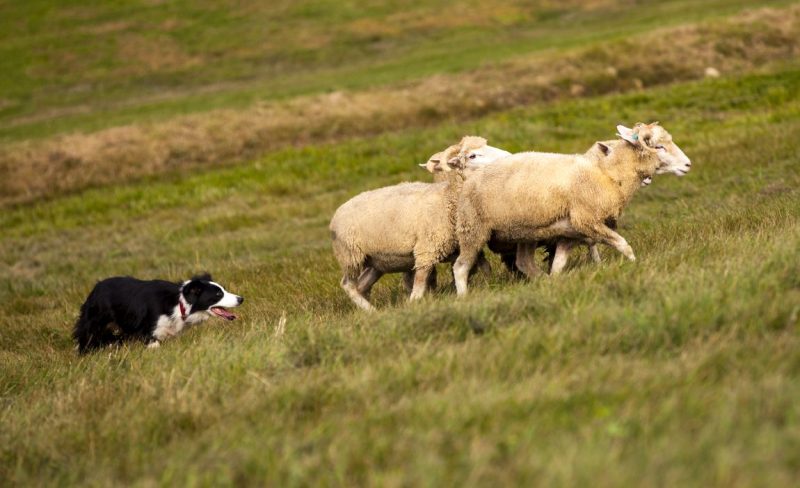
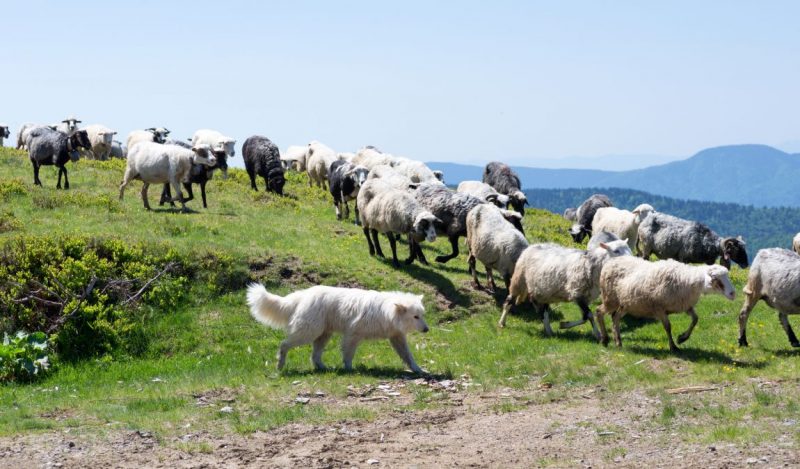


Leave a Comment